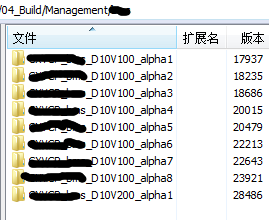从SVN一键对比版本
公司的部署程序太多,每次部署安装完后,还得从SVN上对比版本,手工做实在太麻烦。
比如下面的一个版本

思路:
将需要检查的部件及安装的位置、SVN相关信息写入配置文件,然后程序读取配置文件
配置文件内容如下:
[server1]
ipaddr=192.168.3.2
password=qqqqq
port=
dir=/home/gx/ ----##部件按装的位置
compent=sc,cag,ghomeAgent,IfTImg,Stream,TransDownload ---###服务器上安装的部件 [Server2]
ipaddr=192.168.14.31
password=qqqqq
port=
dir=/home/gx/
compent=bms,bussinessAgent [SVN]
svnserver=192.168.3.185
user=nenenen
password=xxxx
url=http://192.168.3.185/TM/VS/VSP/04_Build
~
因设计到公司内部的产品,代码屏蔽了一些东西:
#!/usr/bin/python
#coding:utf-8
import paramiko
import sys
import subprocess
import ConfigParser
import os,time
import re
import urllib2
from urlparse import urlparse
import unittest #从SVN获取组件及版本号
class snvparser(): aa={}
def __init__(self,url,server,user,passwd): auth_handler = urllib2.HTTPBasicAuthHandler()
auth_handler.add_password(realm='TM Repository',
uri=server,
user=user,
passwd=passwd)
self.opener = urllib2.build_opener(auth_handler)
urllib2.install_opener(self.opener)
self.url=url #print self.url
a=self.opener.open(self.url)
data=a.read()
patten='href="(\w*?)/"'
self.compentlist=re.findall(patten,data)
#print self.compentlist
if 'mvp' in "".join(self.compentlist) or 'GXVCP' in ''.join(self.compentlist):
urldd = urlparse(self.url)
result=urldd.path.split('/')[-1]
self.compentlist.sort(reverse=True)
#print self.compentlist
#print self.compentlist[0]
self.aa[result]=self.compentlist[0]
else:
for self.subb in self.compentlist:
#print self.subb
#print '-'*50
self.suburl=self.url+'/'+self.subb
#print self.suburl
self.openurl(self.suburl) def openurl(self,url):
#self.url=url
#print url
a=self.opener.open(url)
data=a.read()
patten='href="(\w*?)/"'
self.compentlist=re.findall(patten,data) if 'mvp' in "".join(self.compentlist) or 'GXVCP' in ''.join(self.compentlist):
urldd = urlparse(url)
result=urldd.path.split('/')[-1]
self.compentlist.sort(reverse=True)
# print self.compentlist
# print self.compentlist[0]
self.aa[result]=self.compentlist[0]
else:
for self.subb in self.compentlist:
#print self.subb
#print '-'*50
self.suburl=url+'/'+self.subb
#print self.suburl
self.openurl(self.suburl) def result(self):
return self.aa #配置文件判断及读取
config=ConfigParser.ConfigParser()
if not os.path.exists('config.ini'):
print "config.ini is not exists,please check it!!"
exit(-1) config.read('config.ini')
print "You want to check follow Component:"
print config.get('server1','compent')
print config.get('Server2','compent') #SSH远程操作函数
def ssh2(ip,pt,pw,us,comm):
try:
ssh = paramiko.SSHClient()
ssh.load_system_host_keys()
ssh.set_missing_host_key_policy(paramiko.AutoAddPolicy())
ssh.connect(ip,port=int(pt),username=us,password=pw)
#for COMM in comm:
stdin,stdout,stderr = ssh.exec_command(comm)
print "The Installed Version is :",
read = stdout.read()
#print read
compi=re.compile('Implementation-Version:(.*)')
qq=re.search(compi,read).group(1)
#print '======================'
print "\033[36m %s \033[0m" % (qq.strip())
print '-'*30
ssh.close()
except Exception,e:
print "\033[36mError\033[0m is :",ip,e class testCheckVersion(unittest.TestCase):
def setUp(self):
pass
def tearDown(self):
pass
def testVersion(self):
#self.assert(1==2)
pass if __name__ == '__main__':
#print config.sections()
server=config.get('SVN','svnserver')
user=config.get('SVN','user')
password=config.get('SVN','password')
url=config.get('SVN','url')
try: cc=snvparser(url,server,user,password)
result=cc.result()
except Exception,e:
print e
exit(-1)
#print result
#print '='*70 for section_name in config.sections():
if not section_name=='SVN':
print '='*70
configdd=dict(config.items(section_name))
#configdd=getconfig(section_name)
# print configdd
for compent in configdd['compent'].split(","):
try:
if compent=='sc' or compent=='bussinessAgent' or compent=='cag':
comm='cat %s%s-vcp/META-INF/MANIFEST.MF' % (configdd['dir'],compent)
print "The SVN \033[31m %-13s \033[0m Version is:" % compent ,
print "\033[36m %s \033[0m" % result[compent]
ssh2(configdd['ipaddr'],configdd['port'],configdd['password'],us='root',comm=comm)
if compent=='ghomeAgent':
comm='cat %s%s/META-INF/MANIFEST.MF' % (configdd['dir'],compent)
print "The SVN \033[31m %-13s \033[0m Version is:" % compent,
print "\033[36m %s \033[0m" % result[compent]
ssh2(configdd['ipaddr'],configdd['port'],configdd['password'],us='root',comm=comm)
if compent=='bms':
comm='cat %sbms/apache-tomcat-6.0.36/webapps/bms/META-INF/MANIFEST.MF' % configdd['dir']
print "The SVN \033[31m %-13s \033[0m Version is:" % compent,
print "\033[36m %s \033[0m" % result[compent]
ssh2(configdd['ipaddr'],configdd['port'],configdd['password'],us='root',comm=comm)
#if compent=='IfTImg' or compent=='Stream' or compent=='TransDownload':
#comm='ls /home/gx'
#print result except KeyError,e:
print "Please Check input !",e
except Exception,e:
print "Error",e
print '='*70
在写完程序后才发现,公司的SVN 命令太不规范,甚至单词也有拼错;目录安装也非常随意,查看版本方式多样花。一时没心情再将程序往下写了,有需要的可以根据实际情况更改
程序运行如下:
[root@localhost tools]# python checkVersion.py
['sc', 'bussinessAgent', 'cag', 'bms', 'ghomeAgent', 'server1', 'Server2']
======================================================================
sc
:: The Installed Version is: 'NoneType' object has no attribute 'group'
The SVN NESTEST Version is : GXVCP_sc_D10V200_alpha1
======================================================================
bussinessAgent
[Errno None] Unable to connect to port on or 192.168.14.31 --#服务器密码被更改了
The SVN NESTEST Version is : GXVCP_businessAgent_D10V200_alpha1
======================================================================
cag
:: The Installed Version is: 'NoneType' object has no attribute 'group' ---文件已改名了
The SVN NESTEST Version is : GXVCP_cag_D10V200_alpha1
======================================================================
bms
[Errno None] Unable to connect to port on or 192.168.14.31
The SVN NESTEST Version is : GXVCP_bms_D10V200_alpha1
======================================================================
ghomeAgent
:: The Installed Version is: GXVCP_ghomeAgent_D10V200_alpha1
------------------------------
The SVN NESTEST Version is : GXVCP_ghomeAgent_D10V200_alpha1
======================================================================
从SVN一键对比版本的更多相关文章
- svn还原到指定版本
svn还原到指定版本 1,选中文件夹,右健,show log 2,选中指定版本,右健,Revert to this revision 3,svn commit 4,ok
- svn回复历史版本的操作方法
svn恢复历史版本的操作方法svn update 保证最新svn log login.php 获得版本号svn diff -r 11026:11027 login.php 发现11027出问题svn ...
- 细说SVN集中式版本控制器
svn全称Subversion,实现多人开发同一个项目时,对源代码进行管理的工具.在公司里边,一个项目是由多人同时在开发,大家在本地自己电脑开发php代码,完毕后就commit上传给服务器运行. 如 ...
- SVN仓库连同版本信息迁移新服务器的步骤
SVN仓库连同版本信息迁移新服务器的步骤 步骤一:导出(1)链接原服务器,找到SVN Server安装路径下的bin文件,并复制文件路径,如 C:\Program File\SVN Server\bi ...
- linux进阶之SVN集中式版本控制系统篇
代码上线--版本控制系统 SVN 集中式版本控制系统 git 分布式版本控制系统 SVN是subversion的缩写,即版本控制系统,是一个开放 ...
- SVN集中式版本控制器的安装、使用与常见问题汇总
SVN是Subversion的简称,是一个开放源代码的版本控制系统,它采用了分支管理系统,集中式版本控制器 官方网站:https://www.visualsvn.com/ 下载右边的服务器端,左边的客 ...
- SVN源代码的版本控制系统使用简介
SVN是以个开放源代码的版本控制系统,当前最流行的版本控制系统,GIT是近段时间刚兴起的. 下面开始介绍如何安装也配置 1先下载或者从别的地方弄一个安装包(本人是64位的,32位的就用32位的安装包) ...
- SVN 集中式版本控制软件
简介: 目前流行的版本控制软件中,SVN ( 集中式版本控制 ) 算是使用范围更广.且使用时间更早的一款了,现在 git ( 分布式版本控制 ) 更火爆一点. 一.安装svn [root@localh ...
- Linux svn 回滚版本库
Linux代码 svn up Index/ 然后找出要撤销的确切版本: Linux代码 svn log --limit 10 Index/tpl/css/global.css 根据log怀疑是 ...
随机推荐
- iOS彩票项目--第二天,自定义蒙版、封装活动菜单、自定义pop菜单
一.自定义蒙版--封装控件,先想好外界怎么来调用,根据外界调用的方法,然后进入内部实现 在外部,调用蒙版的方法--[ChaosCover show]; [ChaosCover hide]; 内部实现 ...
- Timsort 算法
转载自:http://blog.csdn.net/yangzhongblog/article/details/8184707 Timsort是结合了合并排序(merge sort)和插入排序(inse ...
- R语言中字符串的拼接操作
在R语言中 paste 是一个很有用的字符串处理函数,可以连接不同类型的变量及常量. 函数paste的一般使用格式为: paste(..., sep = " ", collapse ...
- 基于Java的四大开源测试工具
摘要:成功的应用程序离不开测试人员和QA团队反复地测试,应用程序在进行最后的部署之前,需要通过测试来确保它的负载管理能力以及在特殊情况下的工作条件和工作加载情况. %R[)vA t]N0 测试是应用程 ...
- sixxpack破解的文章!【转】
星期天闲着没事玩游戏,玩游戏不能无外挂.于是百度了半天,找到了一个,看介绍貌似不错,就下载了下来.一看,竟然是用.net写的,下意识地Reflector了一下.发现竟是一个叫actmp的程序集.如图: ...
- 建造者模式(build pattern)-------创造型模式
将一个复杂对象的构建与它的标示分离,使得同样的构建过程可以创建不同的标示. 建造者模式是较为复杂的创建型模式,它将客户端与包含多个组成部分(或部件)的复杂对象的创建过程分离,客户端无须知道复杂对象的内 ...
- 调用外部 DLL 中的函数(2. 晚绑定)
, b, t, );end; procedure TForm1.FormDestroy(Sender: TObject);begin FreeLibrary(inst); {记得释放}end; e ...
- Unity 移动端的复制这么写
游戏上线很久了,有些玩家慢慢就流失了,为了让刚流失的玩家再度回归所以做了召回功能!如果一个200级的玩家10天没上线且成功召回的,就会给予召回玩家丰厚的奖励! Q:那如何召回这个流失的玩家呢? A:召 ...
- angularJs 页面{{xxx}}使用三目运算符
<td>{{::item.sex=='w'?'女':'男'}}</td>,记得引号.也可以不用::,用不用::的区别,自行百度
- Windows中目录及文件路径太长无法删除的解决方法
用windows自带的命令解决 win7以上的系统有 robocopy 命令 http://www.jianshu.com/p/95a269951a1b 导致目录太深的原因就是用node中的node ...
